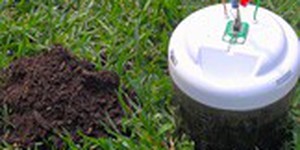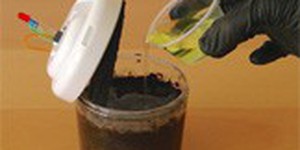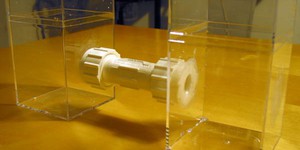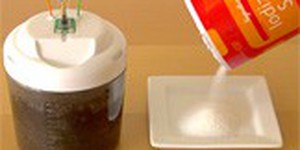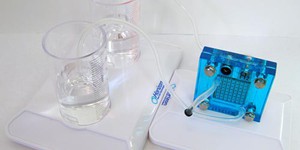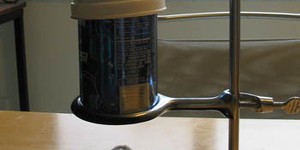Science Projects (472 results)
Browse Science Projects
Over 1,200 free science projects for K-12. Browse by subject, grade level, or try our Topic Selection Wizard to find your winning science project. With science projects in 32 different areas of science from astronomy to zoology, we've got something for everyone!
Let us help you find a science project that fits your interests, with our Topic Selection Wizard.
15 Best Science Projects - Our Scientists’ Picks
|
Select a resource
Sort by
|
What can you do with a bucket of soil? You could use it to grow some beautiful plants and vegetables—or you could use it to produce electricity! Surprised about that? You actually can power electric devices with just mud! Are you curious about how this works? You need some little helpers in the soil—bacteria—that are able to turn their food sources within the soil into electricity in a device called a microbial fuel cell. But is this possible with any soil and does the soil…
Read more
Featured
Have you heard that garlic powder is supposed to inhibit the growth of bacteria? Which do you think would make a better disinfectant: a solution of garlic powder or a solution of bleach? This project shows you a straightforward way to compare the effectiveness of different disinfectants (or other antimicrobial agents), by measuring zones of inhibition on a culture plate.
Read more
Bacteria are powerful little creatures. They can dispose of contaminants, make us sick and did you know they can even generate electricity? In devices, called microbial fuel cells (MFC) they can extract electrons from their food sources such as organic materials and feed them into an electrical circuit to generate power. This way they can even turn plain soil into a source of energy! Does it matter though what kind of food the bacteria "eat"? Find out how bacteria grow in a microbial fuel cell…
Read more
New
Artificial intelligence (AI) programs can now generate photorealistic pictures of people who do not exist in the real world. How can you tell if a picture is of a real person or a fake, AI-generated person? What features of the picture do people use to decide whether the face is real or AI-generated? In this project, you will explore these questions as you ask volunteers to look at both real and AI-generated pictures of human faces.
Read more
Every day, we produce a lot of sewage (wastewater full of feces and urine). In fact, it adds up to 6.4 trillion liters of urine alone produced worldwide each year! The sewage is collected and then treated or disposed of. But what if, along the way, there were a way to make that sewage do something useful? Human urine is rich in nutrients, and some bacteria actually thrive on eating those nutrients. There are also devices called microbial fuel cells that can generate electrical power by using…
Read more
"Gross! What is that in the toilet?" But maybe it's not just gross. Did you know there are bacteria that digest organic waste and create electrons? What if there was a way to collect those electrons to power a circuit? In this science fair project, you will make a microbial fuel cell to collect the electrons that the bacteria—anaerobic bacteria—create...only, you'll be using mud, which is much safer to handle than wastewater. If you would like to learn how to reuse and recycle an…
Read more
Generating power from mud sounds like science fiction, but it is actually real science, and a promising source of alternative energy. Topsoil is packed with bacteria that generate electricity when placed in a microbial fuel cell. Because such bacteria-laden soil is found almost everywhere on Earth, microbial fuel cells can make clean, renewable electricity nearly anyplace around the globe. They are an up-and-coming technology that scientists and engineers are working to make even more…
Read more
New
Engineers are trying to tackle the world's ocean pollution problem using robots. Some robots, like Mr. Trash Wheel and the ship featured in this Mark Rober video, are stationary and collect trash as it flows out of rivers before it gets into the ocean. Others, like the Jellyfishbot, are mobile and can squeeze into narrower spaces to collect trash:
Can you build and test your own trash-skimming robot? If you do not have access to a natural body of water to test it in, you can use a bathtub or a…
Read more
You probably know that turning off the lights and the water, and not wasting paper are all ways to help the environment and conserve our resources. Did you know that another way is to use fuel cells? A fuel cell is a device that converts the energy in chemicals to electricity and it creates no pollution. The starting chemical does not have to be something complex — in fact you it can even be water! In this science fair project try your own hand at converting water to electricity with the…
Read more
Solar cells are popping up on rooftops everywhere these days and are a model for clean, renewable energy.
Did you ever look at those solar panels and wonder how we can get electricity produced by solar cells
when the sun is not shining? It is a great question because solar panels do not produce electricity when
it is dark outside. One strategy to overcome this challenge is to store the energy produced by solar
cells during the day in the form of a fuel that can be used at a later time. In…
Read more
Most of the energy and fuel that we use in the United States is derived from burning fossil fuels. Fossil fuels are the remains of plants and animals that lived hundreds of millions of years ago. Examples of fossil fuels include coal, petroleum oil, and natural gas. Burning coal releases 21.3 gigatons of carbon dioxide— a greenhouse gas that may be responsible for global warming and climate change—into the air in one year. About half of this amount is absorbed by natural processes…
Read more
Have you considered where the gasoline that your parents put in your car comes from and how long that source will last? The fuel that most vehicles use, gasoline, is a petroleum product. Petroleum is a fossil fuel and is a nonrenewable form of energy, meaning we use it faster than it is able to be reproduced. Burning fossil fuels also produces pollutants that might hurt our environment. Using a kind of fuel from a renewable source would help save Earth's natural resources and cut down on…
Read more
Race car drivers need every advantage they can get to give them the competitive edge in a race. In addition to human factors, like driving skill and reaction time, their cars must overcome physical forces, like air resistance, to maintain their high speeds. While this science project will not have you driving around a race track at 200 miles per hour, you will get to test how increased air resistance affects a real car's fuel economy. You will do this by measuring and comparing the gas mileage…
Read more
|



